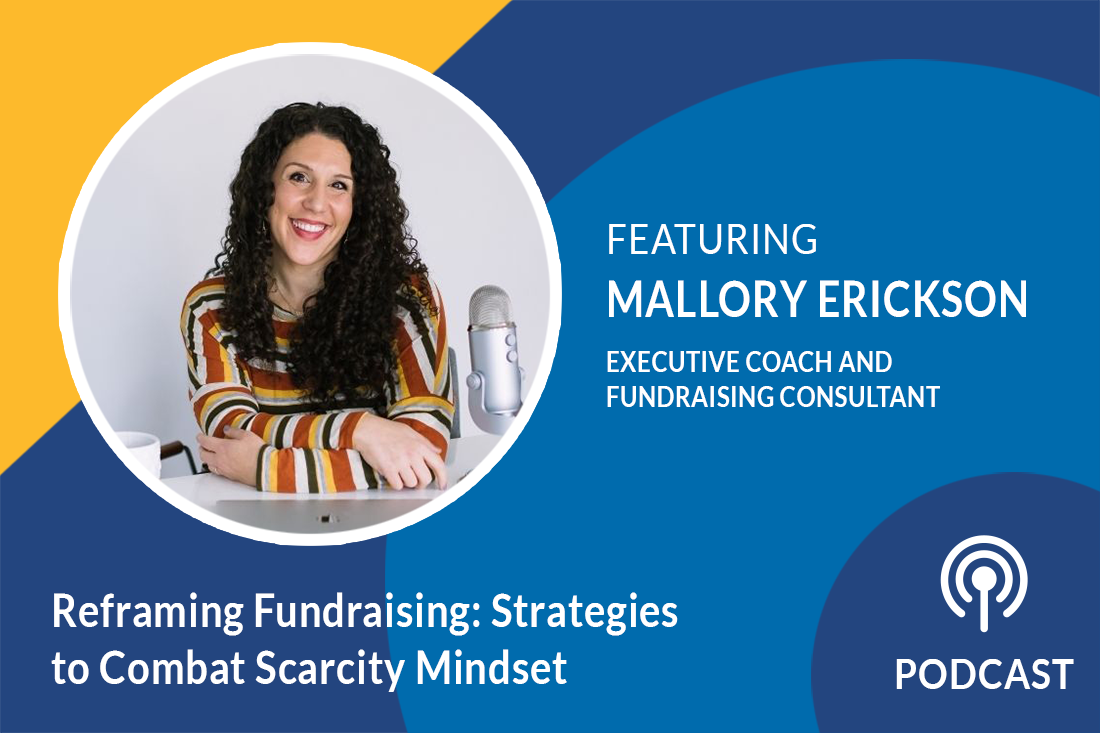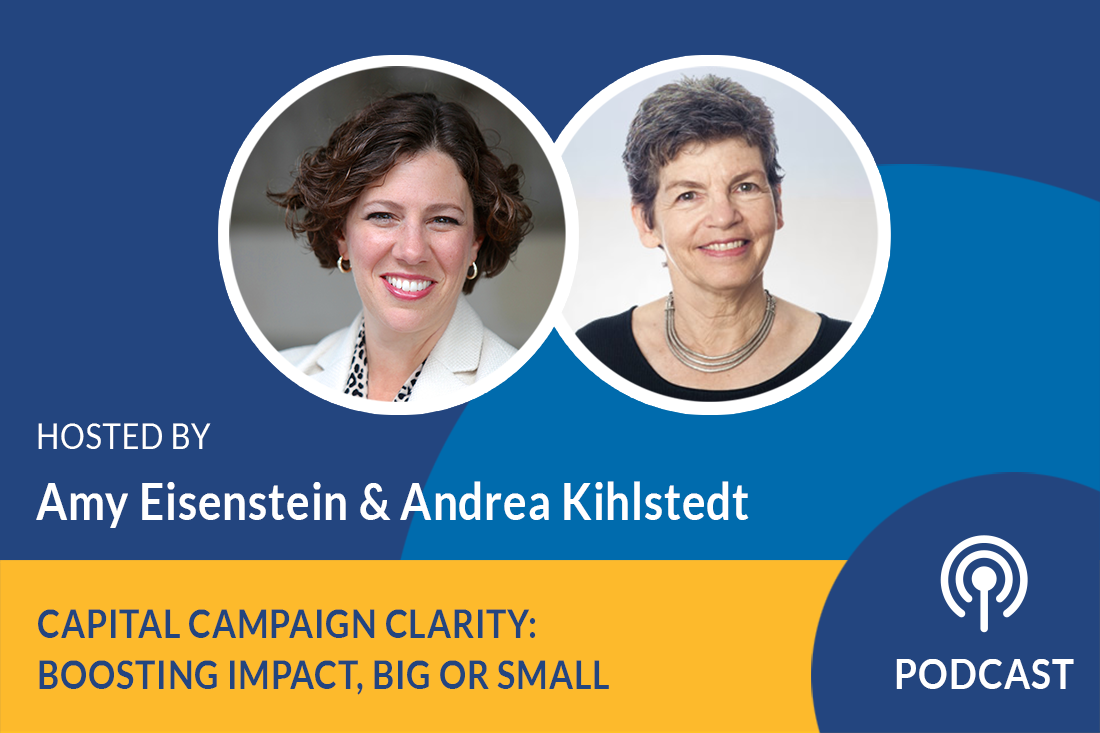Podcast: Use Your Campaign Budget to Ramp Up Your Development Staff

Season 2, Episode 35
In today’s podcast, Amy and Andrea explain how you can use your capital campaign to strengthen your development office and build for the future.
Listen Now:
This episode was recorded as part of a live webinar held Monday, April 18, 2022. To participate in future webinars, register at ToolkitTalks.com.
Andrea Kihlstedt:
Amy, it makes me laugh that you think capital campaign budgeting is exciting. And I suppose it is, but it’s not the topic that would’ve come to the top of my mind as exciting topics.
Amy Eisenstein:
Maybe not exciting — but important.
It Costs Money to Raise Money
Andrea Kihlstedt:
It is important. It is super important, and there are a variety of reasons why it’s important. Early on in your campaign planning process, well, there are a couple of things to know. Let me start right in with the big one, and that is that as you raise money through a capital campaign, you can include in the money you raise the money that you’re going to spend on your capital campaign, right?
You all know, I hope, that you can’t raise money without spending money. It costs money to raise money. Now, if you look at the scope of how much money it costs to raise money, capital campaign fundraising is about the most inexpensive kind of fundraising. And you get the biggest return on investment, the biggest ROI on your investment. And you don’t have to take that money out of your operating budget, you can tuck it nicely into your capital campaign, and you should tuck it into your capital campaign.
For those of you who are worried about telling your donors that you’re actually going to spend some money to bring in that money, I want you to get over that, right? Donors understand that it costs money to spend money, that it costs money to run organizations, that not all money that comes into the organization goes to program. Really, that’s one of the most ridiculous presumptions I’ve ever thought. Organizations that say, “All of your money is going to go to program.” Well, guess what? If there were no money that went to staffing, or any of the other things that makes your program happen, you wouldn’t have a program. And it’s the same with a capital campaign. So don’t hesitate to be perfectly upfront about the fact that your campaign is going to cost money and you are going to include that money in your campaign goal.
Apply the 10 Percent Rule
Okay, got that out of the way. Now, how much money is your campaign going to cost? All right. We like to use a nice rule of thumb, and rules of thumb are questionable, some people have long thumbs and some people have little thumbs, but there are purposes for having rules of thumb. That is that they tend to be simple and memorable and easy to understand. So our rule of thumb for how much money you’re going to spend on your capital campaign is that we like to say, as a starting place, you should budget 10% of your campaign goal towards the expenses of your campaign.
Now, in that context, what do I mean by your campaign goal? Well, the way you come up with a campaign goal is that you add up all the things that you want to spend money on to move your organization forward, and when you total those, you will come up with a working goal for your campaign. You will take 10% of that and that will be your campaign budget, which you will then include in your campaign goal, right? You’re going to add that to your campaign goal.
Now, why do we like that? Well, because pretty much anyone, even the mathematically challenged people, can do 10%, right? It’s easy to do 10% of any number, right? I mean, even I can do 10% of any number and math was never my great forte. So when you tell your board, “We should really budget 10%, or we should imagine that our campaign is going to cost 10% of the goal”, they’ll have a quick understanding that the campaign is going to cost money, and roughly how much it’s going to cost.
Now, a couple of things to know about that. First of all, your campaign, as many of you know, is likely to take up to three years, so that 10% is going to be spread out over three years. It’s not going to be a budget for just one year of your campaign, that money will be spent over the period of time of your campaign. And it will probably not be spent in equal increments over those three years, but we can talk about that in a minute.
The other thing that I want you to know is that while we do use that rule of thumb, 10% rule of thumb, the truth is that there are two important things to factor in when you start getting past the rule of thumb and into the more reality based issues of campaign budgets. One is that because many campaign expenses are fixed expenses, the amount of money you’re going to spend on your consultants for example, is going to be likely fixed, they’re not going to charge you less for a smaller campaign and more for a bigger campaign, so that means that for a small campaign the percentage that you’re going to have to spend is going to be higher. For a big campaign, the percentage that you’re going to have to spend is likely to be lower.
It may be that if you’re doing a $20 million campaign, for example, that you’re not spending 10% of that on your campaign, that maybe you’re spending 7%, right, or maybe even 5%. And if you’re talking a $1 million or a $2 million campaign, 10% probably isn’t going to cut it, right? You’re probably going to need to spend more than that on your campaign.
So you take the rule of thumb, you say, “Okay, that got everyone’s attention, 10% is a nice round number. Now let’s get serious about what this campaign is really likely to cost. And let’s look and see, well, how big is our campaign? What are the costs that are going to be fixed? No matter the size of our campaign.” And then we accommodate as we build our budget accordingly. Amy?
Capital Campaigns Provide a Wonderful ROI
Amy Eisenstein:
Yeah. Let me just chime in and reiterate a few things. You said everything perfectly, I just want to focus in on some of those.
Andrea Kihlstedt:
Do. Good. I like it.
Amy Eisenstein:
All right. I think it is really important to get your board members and your team, your staff, to pay attention to this idea that it does cost money to raise money, and that 10% is an amazing ROI (return on investment), to spend 10 cents to raise a dollar, right? Whether you’re in the business sector or the nonprofit sector, the reality is a 10% investment to raise a dollar is an unbelievable return, so let’s just make sure that everybody understands that.
The second thing is, if your current development team is raising whatever amount, whether it’s a hundred thousand a year or a million a year, anywhere in between, if you expect them to raise, or if they are expected to raise two times that, ten times that, more for a capital campaign, the idea that they would do it with the same exact staff and resources and supports is silly, it’s just ridiculous. Unless somebody’s saying, “Oh, I think my whole development team is sitting twiddling their thumbs”, right? I mean, you’re not, and they’re not. They’re working as hard as they can, and effectively and efficiently, and a campaign is an opportunity to grow your capacity as an organization, and that includes the development team.
That means probably hiring a new staff member, it means contracting expertise of a campaign consultant, it means doing extra things for systems and technology and infrastructure, donor recognition. There is a list of things, there’s a real need for a budget for a campaign. So that’s why we started, am I excited about it or is it important? Both, right?
Andrea Kihlstedt:
Right.
Amy Eisenstein:
I am excited about it. I’m passionate that nonprofit leaders understand that it does take an investment to run a successful campaign. I mean, if you want to raise, whether it’s twice what you raise normally, or 10 times, or more, or somewhere in between, you need more support, guidance, resources, infrastructure, donor recognition, and those things do cost money. But the reality is, it should be only around 10%, so that’s the good news.
Capital Campaigns as Trojan Horses
Andrea Kihlstedt:
Yes. I like it, I like it. Amy, I have often, over these years of working with capital campaigns, thought of capital campaigns as Trojan horses. Do you all know what a Trojan horse is? You remember the Iliad, about the people of Troy? The story is that they want to get into the walls of the city, right, and the only way they can do that is they decide to do it by building this huge, big horse, and they present this horse as a gift to the people of Troy?
And they wheel the horse in to Troy, to the city of Troy, and then lo and behold they had made this trap door in the belly of the horse. Come nighttime, when it’s dark, they lower down the trap door and they let out all of their warriors to create carnage. Now, we’re not into creating carnage with a capital campaign, but if you think about a capital campaign as being a Trojan horse, there are some things you can do in the context of a capital campaign that it’s very difficult to do otherwise.
One of the things you can do is that can remind people that they have to invest in fundraising. The reason you have an opportunity in a capital campaign is because the return on the campaign is going to be so high that people, your board members, are likely to make decisions that they might not make if they had to be dealing just with your annual operating budget.
If you need new systems, if you need additional staff for your campaign, if you want to budget in things that you haven’t been able to actually get the money to do, you can tuck some of that into your capital campaign. Just like the Trojan horse was full of things that the people of Troy didn’t know were in there. I’ve never talked about that so much.
How Much Campaign Staff Do You Need?
Anyway. I do have another big point about budgeting though. Let me get on track here. One of the questions about budgeting for your campaign is, all right, how much staff do you need? How much money is it going to cost? Is it a big campaign or a little campaign, as we’ve already said? But another thing which I think people don’t think about carefully is, what is the elegance culture of your organization? Let me put it that way. How fancy does your organization need to be, right? And some organizations do things in a fancy way. They just do. It’s in the DNA of those organizations to do things in a high end, fancy way. Their board members expect it, their key donors expect it. They create buildings that are fancy, they have events that are fancy. And fancy things tend to cost more, which is why I bring it up here. If your organization has a culture of valuing elegance and the trappings of fanciness, then you have to consider that when you’re putting your budget together.
Consider Your Organization’s Culture When Budgeting
But some organizations have an elegance culture that is quite the opposite, right? I once did a campaign where their kickoff event was under a tent in the field where the bulldozer was pulled up and getting ready to dig into the corn field. And the refreshments for this kickoff event, it was a chilly fall day, and the refreshments for this kickoff were donuts and hot chocolate. And that, for that organization, was perfectly appropriate, as opposed to a three or four course dinner at the fancy event space in town.
Now, you can imagine what a difference the campaign budgets would be in these two organizations. There is nothing wrong with either of those, but the decisions you make have to fit with the culture and the DNA of your organization. And you need to take that seriously in making some of these budget decisions.
Amy Eisenstein:
Excellent. I love it when you tell a good story. I wanted to break in when you were talking your Trojan horse story. But I think it is interesting, because hiring another development staff member, whether it’s a major gift officer, or a development assistant, or administrative assistant, whatever the position, is such a major decision at a nonprofit. But in the context of a campaign, it’s a much easier and much more obvious decision. And it’s easier to swallow when the first year, or two, or three of salary is paid for primarily by the campaign budget, which is separate and apart from your regular operating budget.
So I just want to remind listeners that we have budgeting templates and tools in the Capital Campaign Pro toolkit, for members of the Toolkit. So if you are confused, or curious, or not sure how this is done, and you want to see all of our tools and templates, but specifically to help with budgeting, do consider joining as a member. Reach out and talk to us about what it means to be a member of Capital Campaign Pro, and what resources you get access to.
Final Thoughts on Campaign Budgeting
Any final thoughts, Andrea?
Andrea Kihlstedt:
Yeah, I do have a few final thoughts. I mean, the process that I rather like for creating a campaign budget is to work from the top down and the bottom up. What do I mean by that? Well, if you take 10%, for example. Let’s say you have a $5 million goal and you say, “All right, let me take this rule of thumb and break it down and take 10% of that.” That’s going to be a half a million dollars, right, is 10% of 5 million, I think that’s right. So you can take that five million and you say, “Okay, let me break it out into the key categories that I know have to be in a campaign budget.
Consider Key Categories as You Budget
I know there have to be staffing, and materials, and systems, and donor recognition things, and entertainment and events.” You know what the standard things are, right? And if you don’t, our blog posts that’ll come out tomorrow will give you a list of those basic things. So you take the $500,000 and you break it down by what, over three years, you might want to spend.
Then at the same time, you actually get a budget template, which is much more specific and detailed, over three years, and you start building it up from scratch. And you see how close those two numbers come, right? Breaking it down from the top and building it up from the bottom. I think that’s a great way to think about creating a campaign budget, actually.
Amy Eisenstein:
Good. I think this is such an important topic, and I hope anybody listening does share it with their team, their board members, their executive director, CEO, the rest of the development team, because I think going into a capital campaign without a specific campaign budget is a common mistake that organizations make, and I want to make sure that our listeners do not go into a campaign without a campaign budget.
Apportioning Staff Salaries to the Campaign Budget
Andrea Kihlstedt:
Now, Amy, I have two more things I want to say about the subject. One is this. Most organizations, when they go into a capital campaign, you will find that your executive director, and perhaps your development director, spend a fair amount of their time on the campaign. So the question comes up whether you should apportion some of their salaries to the campaign budget. Given that, let’s say, 30% of an executive director’s time is going to be spent on the campaign, should you take 30% of that person’s salary and put it in the campaign budget? Now, that’s actually pretty good thinking, and it may be what that does is that it provides some relief on your annual operating budget during some of the years of the campaign. And given that everybody is hugely busy, that’s a welcome relief.
What you have to be careful of is that when you get to the end of the campaign, you’re going to have to reapportion those salaries back to your operating budget. If you haven’t accounted for that, and considered that carefully, it’s going to come as a rude awakening when you’re operating budget, that looked so great during the campaign years, all of a sudden is slammed by having to go back to normal. So be sure you do some very good forward planning if you’re going to reapportion some of those budgets.
Amy Eisenstein:
And that’s an if.
Andrea Kihlstedt:
That’s if.
Amy Eisenstein:
You don’t have to, right?
Andrea Kihlstedt:
If. You don’t have to do it, but-
Amy Eisenstein:
Make a decision, make a conscientious decision about whether or not that’s the best course of action for your organization. And there’s pros and cons of doing it both ways, there’s no right or wrong answer. We want to give you all the options to consider and to make well informed choices about your campaign budget. Was there one more thing?
Andrea Kihlstedt:
And now my final thing.
Amy Eisenstein:
Yes.
Aim High for Your Campaign Budget
Andrea Kihlstedt:
My final thing is this, you should always budget for your campaign higher than you really think you’re going to spend, because it’s much easier and more fun, first of all, not to have to go to your board and say, “Well, we need more money for the campaign”, to need re approvals. And it’s much better, so if you have the money that’s already apportioned, then at the end, you can say, “Well, we told you it was going to cost 10% or 12%, in fact, we only spent 7%”, and then you look like a hero.
Amy Eisenstein:
I told you this was exciting.
Andrea Kihlstedt:
It is exciting. You’re right.
Amy Eisenstein:
All right. Good. Listen, thanks for listening. I think this was a great discussion on budgets today, Andrea. I always learn something from your wisdom, so thank you for sharing those great stories and tips.



Leave a Comment